They may not be as powerful as real rifles, but air rifles still serve the same general purpose without the excess cost behind them. For a moderate price, you can still take to the wilds for hunting, target practice, and, if you’re quite proficient with one, official competitions.
With the large market of air rifles out there, how does one choose what works best for them? It doesn’t have to be a game of trial and error, especially if you read through this buyer’s guide, which comes complete with reviews and pros and cons of the best options out there.
Whether you’re shopping for something CO2, spring, or gas powered, you should have no problem picking out the perfect air rifle that checks off most, if not every, box on your wish list.
Best Air Rifles
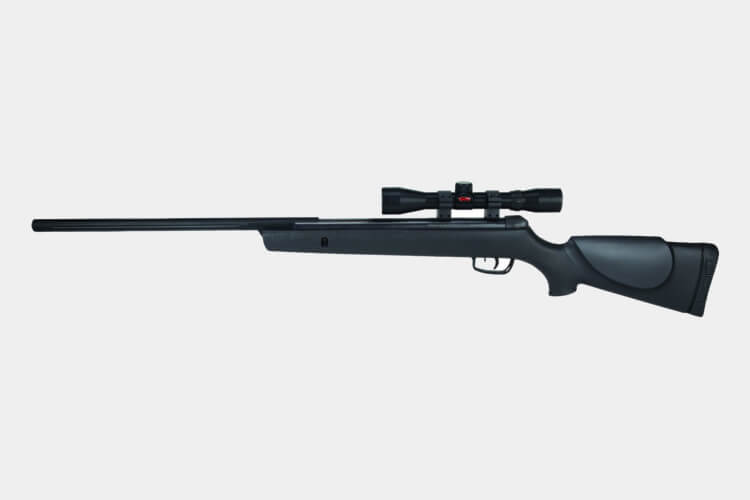 Gamo Big Cat 1250 .177 Caliber Air Rifle w/ Scope
Gamo Big Cat 1250 .177 Caliber Air Rifle w/ Scope
This moderately priced air rifle comes in at 43.3” and weighs a modest 6.1 lbs. Though it’s lightweight and smaller, Gamo didn’t have to sacrifice quality, preferring a tough synthetic build to promise lasting use of the .177 caliber rifle.
Regardless of the weather conditions, the Big Cat will stand up strong thanks to the synthetic material. To prevent discomfort while firing, the butt is covered in a rubber pad that was designed by Gamo to absorb recoil. Shooting left handed or right handed won’t matter thanks to the ambidextrous cheek pads that coat the stock.
Gamo’s Big Cat 1250 fires off lead pellets with a velocity of 1,000 FPS but it’s the PBA Platinum that will fire off with a velocity of 1,250 FPS. For maximum efficiency, the scope increases accuracy with a 4x magnification. Coupled with the maximum velocity, the increased magnification makes it a suitable air rifle for pest control.
Cons:
The undeniably cool name of Crosman’s Nitro Venom doesn’t necessarily mean you’ll be getting a quality product, but the rifled steel stock delivers on an air rifle that will satisfy with each pellet fired. It may not be the strongest on the market at a maximum velocity of 950 FPS, but this Crosman break barrel rifle is equipped with a wide forearm and fluted muzzlebrake for a comfortable Artillery Hold position. The nitro piston that generates the power needed to let your pellets fly is a bit more effective than the standard spring coil. It also provides for a smoother user experience as it’s easier to cock and the recoil is reduced greatly. As an added benefit to the nitro piston, it stands up better in harsher conditions and won’t diminish in quality while in storage for a longer period. Using lead pellets, you’ll get a clean velocity of 800 FPS while an alloy variety will shoot up to 950 FPS. Whether you’re practicing with stationary targets or have your eyes set on small game (where legal), the .22 caliber rifle provides more-than-enough power.
Cons:
This scoped air rifle’s classic look lends to a more authentic feeling when you’ve got it gripped between your fingers. The smooth stock, the barrel length, the silencer – they’re all crafted from high-quality materials to provide lasting use and an effective fire with each trigger pull. Available in .177 and .22 caliber varieties, Ruger’s Yukon is a high-quality model air rifle perfect for any intermediate shooter looking to join a more advanced class. The Yukon, powered by the ReAxis Gas Piston, delivers a high velocity of 1,250 FPS, a power that’s perfect for taking care of small rodents (where legal). The attached 3-9×32 scope provides a great range and clear line-of-sight when targeting smaller targets, moving or stationary. If you’re not pleased with the scope it comes with, feel free to add another with the benefit of scope rails. Ruger’s included silencer, the SilencAir Noise Dampener, is high in quality and efficiency, more-so than most on the market. Its 5-chamber, permanent dampener reduces noise with each shot. Though it has a heavy kickback, the silencer provides a decent drop in unwanted noise, which comes in handy when trying to get rid of unwanted vermin and prevents scaring them before you can get a shot off.
Cons:
The tactical look of this Swiss-made air rifle is attractive, but there’s so much more to it than a great sense of style. The Tac-1 Break Barrel Rifle finds a way to deliver on the high-end features of a more expensive model without forcing users through the added hassle of extra fuss. Each shot is accurate and fires at a velocity of up to 1,200 FPS, depending on the pellet. One of the best features of the Tac-1 is the Swiss Arms Scope, which helps see the 80 yards that this rifle can fire up to. There’s no doubt that this model was made to hunt game considering the power and accuracy. The scope even makes it a great model when it comes to target practice as it delivers on range. The steel barrel, synthetic black stock, and rubber recoil break come together at a comfortable weight while firing, making it easier to line up a shot without fear of getting tired. The barrel ends in a useful muzzlebrake that could be a bit better in reducing the noise of this rather loud air rifle. If it’s stealth you’re going for, you won’t get it with the Tac-1 as it sometimes even beats out .22 calibers that are on the market.
Cons:
The Marauder may look like a powerful air rifle, but its highest velocity only comes in at 900 FPS – not that that’s necessarily a bad thing. Overall, the .22 caliber, 8.9 lb air rifle is a suitable option for beginner and intermediate users. One of the more striking aspects of the Marauder is the synthetic material that comprises the stock. It’s clearly a durable blend that will stand up to all kinds of conditions, whether it’s harsh weather or lengthy storage in an uncontrolled climate. The pull bolt is a heavy-duty metal and the breech is made from a raised aluminum, ensuring every inch of this 48”-long rifle is able to withstand the elements. This Pre-Charged Pneumatic rifle has a reservoir of 250 cc that can be filled up to 3,000 PSI to ensure you won’t have to reload the reservoir throughout the day’s usage. Keep track of the amount of pressure left through the included pressure gauge built into the forearm. The Marauder is equipped with a two-stage adjustable trigger, multi-shot design, and auto-indexing clip are added benefits of this simple model, though there are no open sights, requiring users to aim their shots with the 11-mm rail.
Cons:
At a near-standard 45” in length, this .177 caliber air rifle is a powerful option, though it may look a bit on the simplistic side. Clocking in at a velocity of 1,200 FPS, this isn’t some toy that anyone could use. Solidifying that fact is the 25lbs of cocking force, which is sure to prevent smaller hands from being able to load this single shooter. As an added benefit, the Optimus prevents unwanted firing by engaging the safety after its cocked. Aiding in accurate aiming is a fiber optic front sight and an adjustable rear sight, making a scope unnecessary unless you’re going for distance. Perfect for intermediate shooters, the Optimus comes in handy during target practice and when there’s a small pest that needs ridding. For the price, this classic-looking Crosman is everything you could want out of an air rifle. Make a few adjustments to the trigger pull and you have yourself a model that’s quick on the draw with great accuracy and decent speed.
Cons:
With a name like “Blackhawk,” you know you’re going to get something that’s sleek and effective, and this composite-made combo air rifle checks off both boxes. It may be a little on the heavier side at 9.6 lbs, but that weight is just an indication of its durability and weather-resistance. Equipped with a fixed front sight and adjustable rear one, you’ll have plenty of aiming assist, but the included nitrogen-filled 4x magnification scope certainly doesn’t hurt. Shockproof, fog proof, and waterproof, this isn’t some aftermarket scope that will break after a few uses. The .177 caliber rifle shoots lead pallets at a minimum velocity of 1,000 FPS, but it’s the alloy pellets that can sore with much greater power. Be sure you know what you’re aiming at before you pull the trigger as that kind of velocity can do some damage. Each shot is powered by a spring piston, which will require a little extra care in the long run but is still a reliable option. The very-light 3 lbs trigger pull makes each shot quick and easy.
Cons:
There are attractive rifles and then there’s the Gamo Whisper, a truly sleek black model that looks just as good hanging on the wall as it does in the user’s hands. Beyond being a model designed with style in mind, it’s also an effective air rifle capable of firing off PBA pellets at 1,200 FPS. The .177 caliber Silent Cat is moderately light, at 7.3 lbs, though it is a bit longer at 48”. The stock is made from a durable black synthetic material that gives the Whisper Silent Cat rifle its unmistakable design while providing for a durable build that can withstand the harshest of elements. At the end of the stock is a rubber recoil pad that absorbs the force of each powerful shot, lowering the kickback for more comfortable use. This model comes equipped with a 4×32 air rifle scope complete with rings and is designed with a permanent noise dampener. While the dampener works fine with most pellets, firing off PBA pellets will produce the same level of noise regardless. At that point, it’s more aesthetic, though it does nearly eliminate noise from any other pellet.
Cons:
The Umarex 2251300 Surge Combo is 9 lbs of German engineering, a quality air rifle marked by a sleek design, one of the most attractive one-shot air rifles out there. Right off the bat, it’s impossible to miss the 4×32 scope, which works perfectly for beginner users and more accustomed shooters. Expect to draw attention with this considerably loud air rifle as you get used to the power behind the .177 calibers fueling this model. Despite the muzzlebrake, noise reduction is at a minimum, so you’ll hear every powerful shot whether it’s the rifle’s first or its 100th. The cocking power is on the higher end, topping out at 30 lbs. The Surge balances between being a beginner’s rifle and being built for intermediate users and serves kind of in the middle. The cocking power, caliber, thumbhole stock, rear dovetail mount, and loud firing all come together in a rifle that will appeal to a variety of users. Enjoy a range of compatible optic sights and the comfort of a recoil pad at the end of the stock for a more professional experience or take the rifle as-is.
Cons:
Remington is a name that even newcomers to the air rifle or gun industries know. It’s synonymous with a quality product that so many have trusted in. When it comes to air rifles, Remington doesn’t skimp, especially with the Tyrant. Remington’s mid-range air rifle is a bit too complex for beginners but is the perfect model for hobbyists as it runs off a spring operated compressed air system. This replaces the CO2-only pressure model and allows for a higher velocity (1,200 FPS) and a much more powerful shot. The sleek design comes equipped with a 4×32 scope that makes aiming incredibly easy, especially as the scope is of better quality than many. It may take a little adjusting here and there for the perfect line-up of your shot, but the scope and mount are a great feature on this already reliable rifle. With the perfect shot, the high velocity of the pellet makes this gun great for small rodents and other pests (where legal). The stock is made of a synthetic material that holds up over time, regardless of the amount of use and the conditions it’s put through. Made for all types of shooters, the stock is ambidextrous and comes equipped with a two-stage adjustable trigger for efficient firing.
Cons:
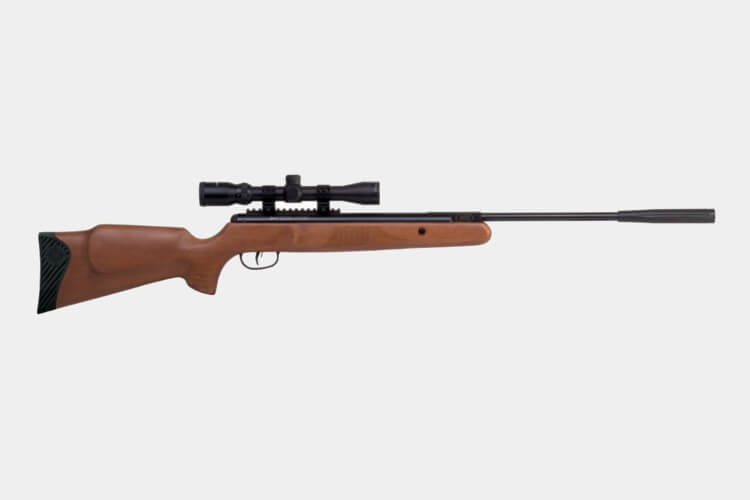 Crosman Nitro Venom Break Barrel Air Rifle w/ Nitro Piston
Crosman Nitro Venom Break Barrel Air Rifle w/ Nitro Piston
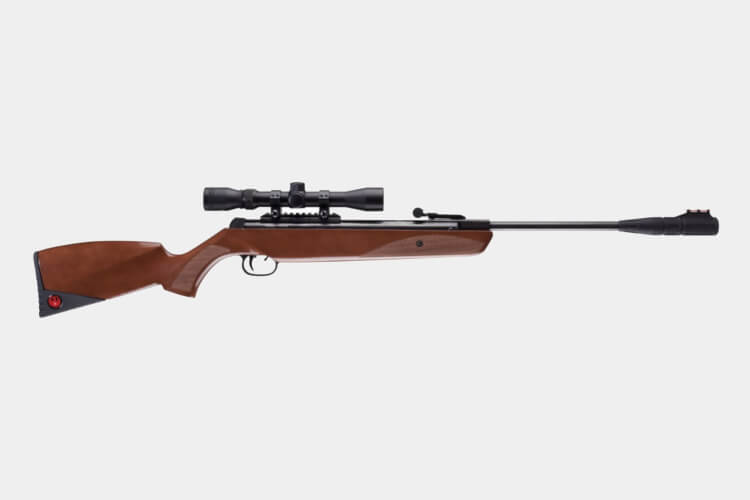 Ruger Yukon Air Rifle
Ruger Yukon Air Rifle
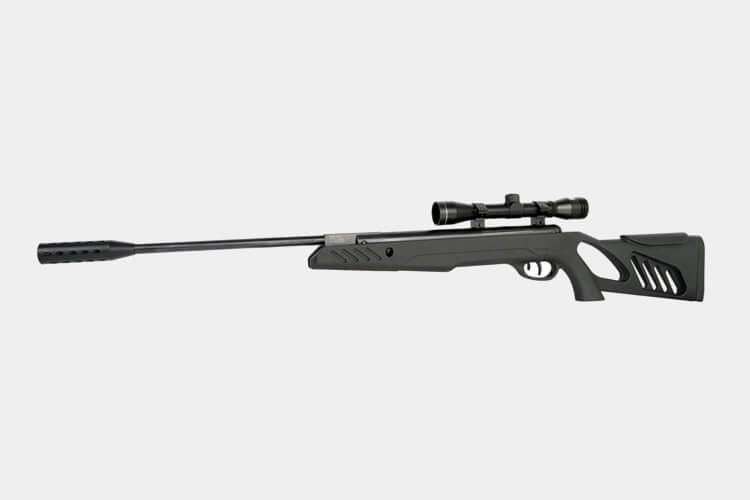 Swiss Arms 288723 Tac-1 Break Barrel
Swiss Arms 288723 Tac-1 Break Barrel
 Benjamin Marauder Synthetic Stock Pellet Air Rifle
Benjamin Marauder Synthetic Stock Pellet Air Rifle
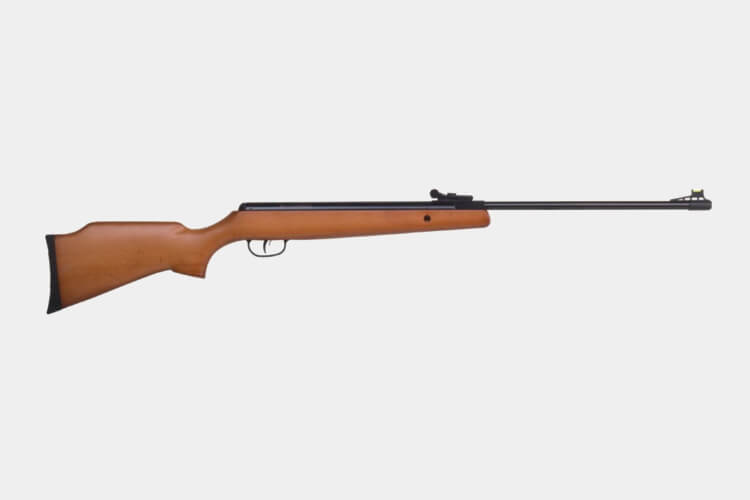 Crosman Optimus Break
Crosman Optimus Break
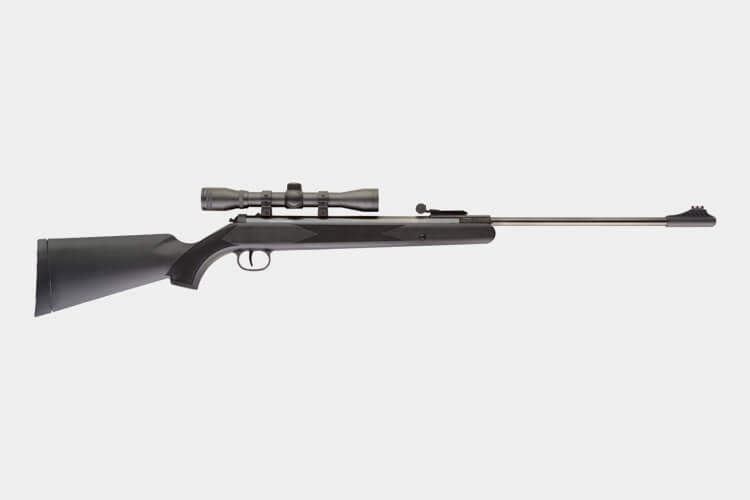 Ruger Blackhawk Combo Air Rifle
Ruger Blackhawk Combo Air Rifle
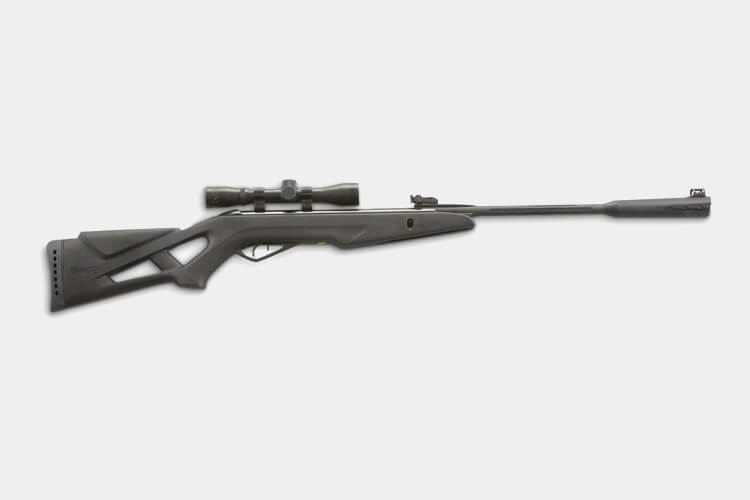 Gamo Whisper Silent Cat Air Rifle
Gamo Whisper Silent Cat Air Rifle
 Umarex 2251300 Surge Combo
Umarex 2251300 Surge Combo
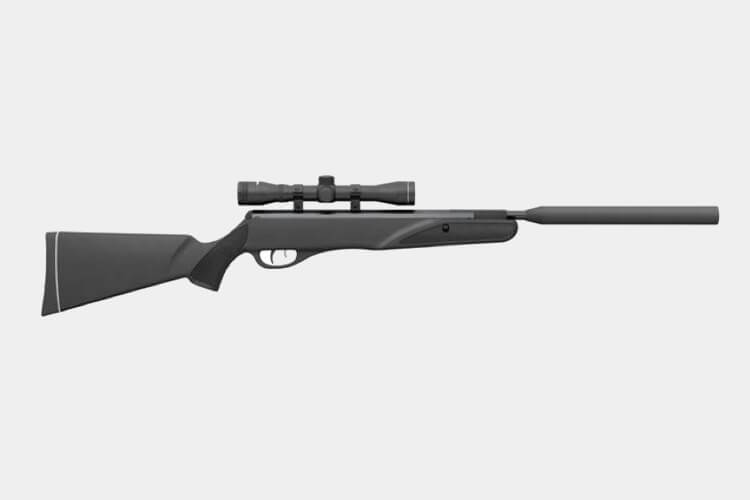 Remington Tyrant Air Rifle
Remington Tyrant Air Rifle
Air Rifle Buyer’s Guide
What Every Future Rifle Owner Should Know
Purchasing an air rifle isn’t quite like pulling the nicest looking item off the shelf. Though visual appeal may play a small part in the rifle you wind up purchasing, every future enthusiast should understand every minute and major detail about the air rifle they’re looking to own. Before you lay down the cash for a rifle or an air pistol, make sure you can answer all of the following questions:
- What caliber is it?
- What’s the shooting velocity?
- What material is it made out of?
- Will it stand up to extreme weather conditions?
- Does it even serve the purpose I need it to?
- Can I afford the ammo for it?
- What safety features does it have?
- Is it even legal for me to own it in my city or state?
Know the ins-and-outs of the rifle you’re eyeing up and know what it’s made of and what powers it. If you’re used to firing one type of rifle made of one material, getting into a different type will likely come with subtle changes that you should be aware of before you start firing.

Most importantly, before you even start eyeing up the possibilities in store, consider these four things:
Why Do I Want an Air Rifle?
Some people just enjoy the novelty of owning such an item. They may think they’ll dive right into it, but once they unpackage the rifle, they’ll grow a little overwhelmed and put it in a corner of the attic or garage.
Make sure you have a clear purpose as to why you want to own an air rifle. Do you just want to partake in some target practice or maybe enter yourself into a formal competition? Are you hoping to hunt small game with it? Knowing why you want to own one is key to knowing what you’ll be looking for.
Hunters will want something with a higher velocity and reduced noise while more competitive shooters are going to want a reliable scope, reduced recoil, and a rifle that shoots at a greater distance. If you’re just looking to get into a hobby, you’ll be looking for maximum simplicity.
What Range Will I Be Shooting At?
Are you going to be picking off targets at 80 yards away or zeroing in on some critter that’s 35 yards? Knowing what distance you’re shooting up to is pretty important to know what rifle you want to go with. The four categories of rifle – light, medium, high, and super high-powered – all provide different distance ranges.
Light rifles are best for short-range shooting, up to 35 yards, while super high-powered rifles should get you to up to 80 yards without a problem. Frankly, the super high-powered variety is an all-around great model for any distance as it’ll shoot up to 35 yards without a problem.
Can I Budget for Useful Accessories?
Though air rifles are ready to use right out of the box – sometimes with a few adjustments needing to be made – some offer an abundance of accessories that can be added to enhance the experience. If you buy a rifle without a scope, chances are you’ll be able to add one. Sights may also need to be purchased and added.
Keep in mind what accessories you may need to buy to fully outfit your rifle. It may be more affordable to buy a rifle that comes equipped with a scope and muzzlebrake rather than try to add one later. If the quality isn’t what you’re looking for, simply swap it out when you can afford to.
Accessories that you may wind up wanting to add later on include:
- Targets
- Chronographs
- Curious how fast your pellets are traveling after being fired? The chronograph will measure it in feet per second.
- Tools for cleaning and maintenance
- Keeping your rifle clean is imperative for it to last.
- Clips and loaders
- Adjusting your clip or loader can make reloading pellets easier.
- Glasses or goggles
- Always practice suitable eye safety, even if you have a firm grasp on how to use your rifle safely.
- CO2 cartridges
- See “Types of Rifles” below.
- Green gas
- This lubricating agent keep your rifle firing smooth and conditions it for reduced friction.
- Trail Cameras
- Keep an eye out for the game you’re hoping to hunt.
Overall Cost
You never want the overall price of something to be a major factor in what you wind up purchasing, but sometimes it’s unavoidable. Consider your budget as you’re shopping, not just in regard to the longer term and accessories, but also what you’re willing to spend up front. Higher end rifles are going to cost more, but they’re also going to be more durable and last longer.
Types of Rifles
With the basics answered, now it’s time to ensure you know the difference between the three different types of rifles. Your choice will either be C02 Powered, Pneumatic, or Spring Powered and each one carries its own set of advantages and disadvantages.
C02 Powered
Rifles powered by CO2 use compressed gas for every pellet fired. They’re typically outfitted with reserves or gas cartridges that need to be refilled or changed out after so many shots.
Advantages:
- No Pumping: The CO2 is ready to go without the need to pump after each shot. You can continuously fire so long as there is gas in the reservoir and pellets in the chamber.
Disadvantages:
- Lack of Power: The use of gas reduces power and velocity a bit when compared to spring or pneumatic rifles. You may need to use lighter pellets for a more effective shot.
- Expensive in the Long Run: It won’t take long for you to realize just how expensive CO2 cartridges/refills can be when you have to replace it. If you’re going to be using your rifle a lot, you’ll be pumping plenty of money into CO2.
Pneumatic
If you don’t mind stopping to pump air into a chamber after each shot, then the pneumatic air rifle may be a suitable choice for you. Though it may sound like a pain to have to pump the rifle about 5 to 10 times before being able to fire each shot, there are plenty of advantages to this type of model.
Advantages:
- Inexpensive: Utilizing air allows the pneumatic rifle to be more affordable than other options. There’s no need to change out cartridges or replace springs over time.
- Versatile: The pneumatic model can shoot both pellets and BB with no issue.
- Varied Velocity: Need to have a greater velocity? Pneumatic rifles can be altered a bit to allow for more power.
- Great for Beginners: Since there are typically no bells and whistles, the pneumatic rifle is a great starter gun for beginners and younger users.
Disadvantages:
- Inconvenient: If you need to fire off rounds a bit quicker, having to stop to pump after each shot will slow you down. Having to pump can also become exhausting during lengthy target practices.
Spring Powered
Using a spring-powered piston, these air rifles provide a high velocity and increased accuracy. The rifle compresses air within its chamber for a more powerful shot. Spring powered rifles come in three different varieties:
Side Lever: The cocking lever can be found on the right side and is pulled back to cock the rifle.
Underlever: The lever is located beneath the barrel and requires the side lever to be pulled in order to cock the rifle.
Break Barrel: A common method, the barrel itself is hinged and can be pulled down to reset the spring.
Each type of spring-powered rifle comes with its own advantages, though they all provide the same level of velocity.
Advantages:
- Power: The compression and spring powered fire delivers a powerful shot with each pull of the trigger.
- Ease-of-Use: No pumping and no exchange CO2 cartridges. The spring powered rifle is among the easier to use.
Disadvantages:
- Difficult Cocking: The manual cocking of the spring powered rifle can be a bit more difficult for younger or smaller users.

Hunting with an Air Rifle
Before you even consider purchasing an air rifle for hunting or pest control purposes, you need to stop an ask yourself: “Am I even able to use it for this purpose?” Ensure you check with local laws – both state and city level – to see what may or may not be prohibited when it comes to air rifles and hunting certain animals.
A good rule of thumb is: If you don’t know or can’t find out, assume it’s against the law until you can get clarification.
What Can I Shoot at with an Air Rifle?
Believe it or not, “people” is nowhere in the list of things you can shoot with an air rifle. In fact, even though you’re not firing real ammunition, you should never point an air rifle at a person, even as a joke. Though it may not seem like it, a misplaced pellet or BB round can cause serious damage and death, especially with higher velocity rifles.
What you’re shooting at is going to determine the velocity and caliber you want to go with. Targets don’t require a high velocity, but piercing an animal’s skin may. Be sure, if you are looking at live targets, that you consider local and state laws before turning your rifle on a critter.
When it comes to live quarry shooting, you will probably be hunting on your own territory or you may find someone willing to open their property up to you. Typically, these people will be dealing with pest problems – foxes, rabbits, squirrels – are will give you permission to hunt them on their land. Most of the time, this is offered:
- To preserve public health and preserve the safety of other species
- Prevent the spread of infectious disease
- Cease damage to livestock and crops
- Prevent population spurts
In areas where hunting game is legal, always make sure you have the proper licensing before accepting an offer to hunt on anyone’s property or in the wild. Certain game, like foxes, duck, and deer, may be protected by seasonal hunting.
If you can stave your need to fire upon Mother Nature’s creatures, there are a variety of different things you can unload your pellets and BBs into. Many air rifle users stick to stationary targets, such as papers or tin cans. Unlike live targets, you can set up these stationary targets to be at distances you want to shoot at. This provides you the opportunity to practice at various ranges and heights.
While shooting targets in your backyard can be fun, there’s also the opportunity for more formal shooting at clubs. With clubs, there are typically membership or daily fees to consider, but they often provide the targets and a safe, weather controlled environment to test your rifle in.
If you’re shooting on your own property, make sure there is a backstop in place to prevent pellets or BBs from going into another person’s land.



